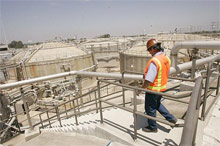The Orange County Sanitation District is about to begin converting human waste into hydrogen fuel in a first-of-its-kind attempt to turn sewage into a salable product.
The district, along with UC Irvine researchers and private companies, has agreed to install the new device in an $8 million demonstration project that could begin operating by May.
And if it takes off, sewage treatment plants around the country could one day double as gas stations – emphasis on the gas.
"The waste stream from society is being turned around, and providing energy and transportation fuel for the society," said Scott Samuelsen, director of UC Irvine's National Fuel Cell Research Center who helped develop the new fuel-cell device.
Society is unlikely to run out of human waste anytime soon.
"This is the epitome of a sustainable technology," he said.
The Sanitation District has used methane gas from sewage to power its systems for years. The new device, built by Air Products of Pennsylvania and FuelCell Energy of Connecticut, takes this much farther: it will use methane to provide three separate streams of energy.
The methane comes from the sewage plant's 'digesters,' large chambers where sewage is heated, allowing bacteria to break it down into methane and carbon dioxide.
First, the methane will be used in the traditional way, to generate electricity. Second, waste heat from the fuel-cell device will be recaptured, and pumped back into the digester to help heat the sewage.
And third, hydrogen will be chemically separated from the methane and pumped into storage tanks, where it will be ready for use in hydrogen cars.
The process emits small amounts of carbon dioxide, a heat-trapping gas, but because it is generated from waste gases, there is no net increase of carbon in the atmosphere.
And it produces only tiny amounts of other pollutants – far less than produced in the more common method of stripping hydrogen from natural gas.
"It's almost immeasurable," Samuelsen said.
The project's biggest hurdle at the moment is its cost. The pricetag for energy produced by the new device, once installed, is $4,000 to $5,000 per kilowatt, while typical internal combustion engines that power the Sanitation District plant cost about $1,000 a kilowatt.
Samuelsen said as the technology improves and becomes more widespread, the costs will drop, perhaps to a competitive level.
Testing the new system at the Sanitation District should give its creators a sense of how well it will do in the broader market. If it succeeds, it could be used on other kinds of waste, such as that produced by food processing plants.
"Now it's a question of developing the market, proving the technology and getting the cost down," said Ed Heydorn, business development manager for Air Products.
Ed Torres, the district's director of technical services, said sewage treatment plants also must worry about mandated reductions in emissions of greenhouse gases and other pollutants. That could also provide an incentive for switching to fuel cells.
Right now, replacing all the Sanitation District's gas engines with hydrogen fuel cells would be far too expensive – about $200 million, even without generating extra hydrogen for car fuel.
But if grants and other incentives are available, and the systems help sewage plants meet their clean-air goals, they could become much more attractive in the years ahead. That could lead to increased use of hydrogen fuel cells at the district.
"That's an interest if this works," he said. "And we may end up pursuing something along those lines."
That is why it is worth doing the demonstration project and testing out the technology, he says.
"It's much cleaner, greener technology, much more efficient," Torres said.
The makers of the device are now working out an agreement with the state Air Resources Board, which should be made final in a matter of weeks, said Gerhard Achtelik, manager of the air board's zero emission vehicle infrastructure section.
And there are growing numbers of potential customers. General Motors is market testing more than 100 fuel-cell Chevrolet Equinox sport utility vehicles around the country, many in the Los Angeles area, while Honda is leasing some 200 FCX Clarity passenger cars over the next three years in the Los Angeles area and in Orange County.
"Part of why the state is involved is to assure open access," Achtelik said.
To buy hydrogen fuel and fill up at the Sanitation District, drivers will have to receive training first, then a go-ahead from the district, he said.
Torres said he looks forward to people driving onto the Fountain Valley site to fill up their tanks.
"We're at a prime location, right off the freeway – an excellent location for people looking for near access,"

